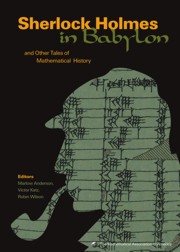Book contents
- Frontmatter
- Introduction
- Contents
- Ancient Mathematics
- Medieval and Renaissance Mathematics
- The Seventeenth Century
- The Eighteenth Century
- Foreword
- Brook Taylor and the Mathematical Theory of Linear Perspective
- Was Newton's Calculus a Dead End? The Continental Influence of Maclaurin's Treatise of Fluxions
- Discussion of Fluxions: from Berkeley to Woodhouse
- The Bernoullis and the Harmonic Series
- Leonhard Euler 1707–1783
- The Number e
- Euler's Vision of a General Partial Differential Calculus for a Generalized Kind of Function
- Euler and the Fundamental Theorem of Algebra
- Euler and Differentials
- Euler and Quadratic Reciprocity
- Afterword
- Index
- About the Editors
Euler and Differentials
from The Eighteenth Century
- Frontmatter
- Introduction
- Contents
- Ancient Mathematics
- Medieval and Renaissance Mathematics
- The Seventeenth Century
- The Eighteenth Century
- Foreword
- Brook Taylor and the Mathematical Theory of Linear Perspective
- Was Newton's Calculus a Dead End? The Continental Influence of Maclaurin's Treatise of Fluxions
- Discussion of Fluxions: from Berkeley to Woodhouse
- The Bernoullis and the Harmonic Series
- Leonhard Euler 1707–1783
- The Number e
- Euler's Vision of a General Partial Differential Calculus for a Generalized Kind of Function
- Euler and the Fundamental Theorem of Algebra
- Euler and Differentials
- Euler and Quadratic Reciprocity
- Afterword
- Index
- About the Editors
Summary
Two recent articles by Dunham [5] and Flusser [10] have presented examples of Leonhard Euler's work in algebra. Both papers are a joy to read; watching Euler manipulate and calculate with incredible facility is a pleasure. A modern mathematician can see the logical flaws in some of the arguments, yet at the same time be aware that the mind behind it all is that of a unique master.
These two articles reminded me how much fun it is to read Euler. In researching the evolution of the differential a few years ago, I found the work of Euler refreshingly different from that of other seventeenth- and eighteenth-century mathematicians. One can read about Euler's use and misuse of infinite series in most histories of mathematics (e.g. [2, pp. 486—490]). This paper offers a glimpse at how Euler used infinitesimals and infinite series to compute differentials for the elementary functions encountered in a typical undergraduate calculus sequence. I hope the reader of this brief survey of Euler's work with differentials will seek out original sources such as [8] and [9]. As Harold Edwards [7] has cogently argued, we have much to learn from reading the masters.
Euler and the 18th century
Euler (1707–1783) was the most prolific and one of the most influential mathematicians who ever lived. He made major contributions to both pure and applied mathematics and his collected works amount to over 70 volumes. So strong was his influence that historians like Boyer [2] and Edwards [6] refer to the eighteenth century as the Age of Euler.
- Type
- Chapter
- Information
- Sherlock Holmes in BabylonAnd Other Tales of Mathematical History, pp. 369 - 374Publisher: Mathematical Association of AmericaPrint publication year: 2003
- 1
- Cited by



